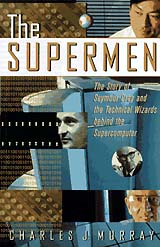
The need for speed
|
This review first appeared in the American Reporter in 1997.
Thirty years ago, Cray – who died after an automobile accident in 1996 – was already designing computers that were faster then than the highest-end Power PC, Alpha, Sparc or Pentium chips today. A quarter-century ago, he was already dreaming of computers that could operate at speeds of a gigahertz and up.
To put it in perspective, a gigahertz is 1,000 times faster than 1 megahertz; the Apple IIe and Commodore 64 of the early 80s ran at about 1.8 MHz, while a standard PC today runs at about 150 MHz, or 100 times slower than the Cray 2.
Like a race car driver, a downhill skier or any other speed freak, Cray was possessed by the need to go faster. And during the Cold War, he had customers aplenty, from government weapons labs to the military to allied nations. Others, too, craved the raw power Cray delivered – airplane manufacturers, oil companies, research universities.
And in building the world's fastest computers, Cray not only became the first superstar of the computer world – long before Bill Gates knew what binary code was, before Steve Wozniak ever soldered a chip into an Apple, before Nolan Bushnell had even thought of Pong – he also revolutionized the computer industry, and helped invent the supercomputer.
Charles J. Murray's new book on Cray, "Supermen," is a quick read; a charming but light look at the man whose name became synonymous with supercomputers. Technophiles will find no details of Cray's machines here; those who want a deep look at the subject's every thought from a biography will also go away hungry. His divorce after 30 years of marriage rates not even a full sentence; his childhood is similarly compressed.
What Murray does give us is a popular account of Cray's professional life, one that is well-written and smartly composed. After you read it, you feel good, that you knew Cray a little better.
This isn't the definitive bio of Cray, but it's a nice introduction to one of the most influential figures in the short history of electronic computers.
